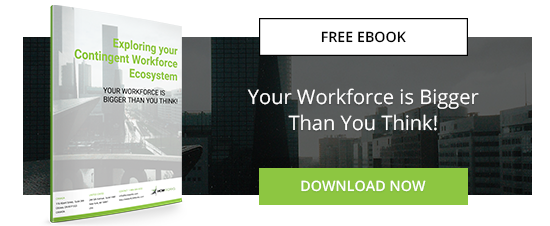A contingent worker is typically defined as a resource who conducts work for specific or limited time period for an organization they are not an employee of. These workers come in the form of freelancers, independent contractors or are employed by third parties (staffing suppliers). They typically work under a contract, on a temporary basis, or provide consulting services, on an as-needed basis.
One of the big changes that has happened over the years, is that the hiring of contingent workers is no longer just for lower paid jobs in retail, manufacturing or administration sectors, but now more and more, contingent workers are commonly working in strategic positions in IT, Finance, Medical, Engineering and Sales professions.
This has made the management of a contingent workforce more intricate, more complex, with ramifications across nearly every facet of the average business. The contingent workforce is now more strategic than ever, and requires clear management.
From a strategic perspective, two functional groups sit at the forefront of contingent workforce management – Procurement and Human Resources. However, many of today’s businesses have not fully resolved the legacy approaches to managing a contingent workforce – and more innovation is needed in this fast-changing sector.
Procurement and HR bring a different set of skills to the table, each with specific advantages that traditionally address either the spend side or the supplier side of contingent workforce management and talent acquisition.
Traditionally, procurement sees cost saving opportunities within contingent workforce management, while the HR function perceives contingent workforce management as a talent opportunity.
The differences between procurement and HR is built upon traditional organizational systems that were formed decades ago, and which now set the foundational attitudes around contingent workforce management.
Unfortunately, when a gap between these two areas appears, it impacts the true business value in the equation – why the contingent workers are being hired in the first place, how to manage specific skillsets, how to build technical expertise, and what does a workforce competitive advantage look like?
A well-managed contingent workforce is a considerable asset as it provides an organization with the ability to utilize resources that are flexible, skilled and dynamic, and gain that competitive advantage every business needs.
On the flip side, a mismanaged contingent workforce is potentially damaging to an organization, as it increases its exposure to risk and costs - with no defined strategy on increasing productivity.
For businesses to maximize the impact and true value of their contingent workforce, HR and Procurement must work together to foster collaboration and promote cross-functional strategies, that not only generate cross-organization visibility of the program, but generate more data, intelligence, and enhanced control - leading to the strategic approach we want.
Another area we need to consider is that procurement and HR are measured and rewarded differently. Procurement, and the management of contingent labor, can be so complex and intertwined that it becomes difficult for one department in an organization to tackle the solution in isolation.
Procurement can create significant front-end savings for organizations by treating the service as commodity. However, they are generally not measured on the actual service, quality of work and liability. That’s why it’s important for Human Resources to assist and take responsibility not only for an individual talent engagement, but for the entire contingent workforce. Factors such as diversity also need to be considered in this process and this is an HR specialty.
It’s for this reason that the two departments need to work together, to minimize risk and maximize performance and savings, so we need to align their strategies and collaborate on this complex but critically important component. Otherwise, it becomes a real challenge to address any of the other issues that may similarly be crucial to the organization’s overall success.
Now that we have a full grasp on the complexities of the contingent workforce - we are seeing an emerging trend towards more formal third party contingent workforce management models.
Due to a range of factors including: delivering complex cost saving initiatives, intricate supply chains, expert knowledge and risk mitigation, many organizations choose to work with third party contingent workforce Managed Service Providers MSPs. MSPs assist with shaping and delivering an effective and efficient contingent workforce solution, and help organizations realize cost savings and competitive advantage through better access to talent.



